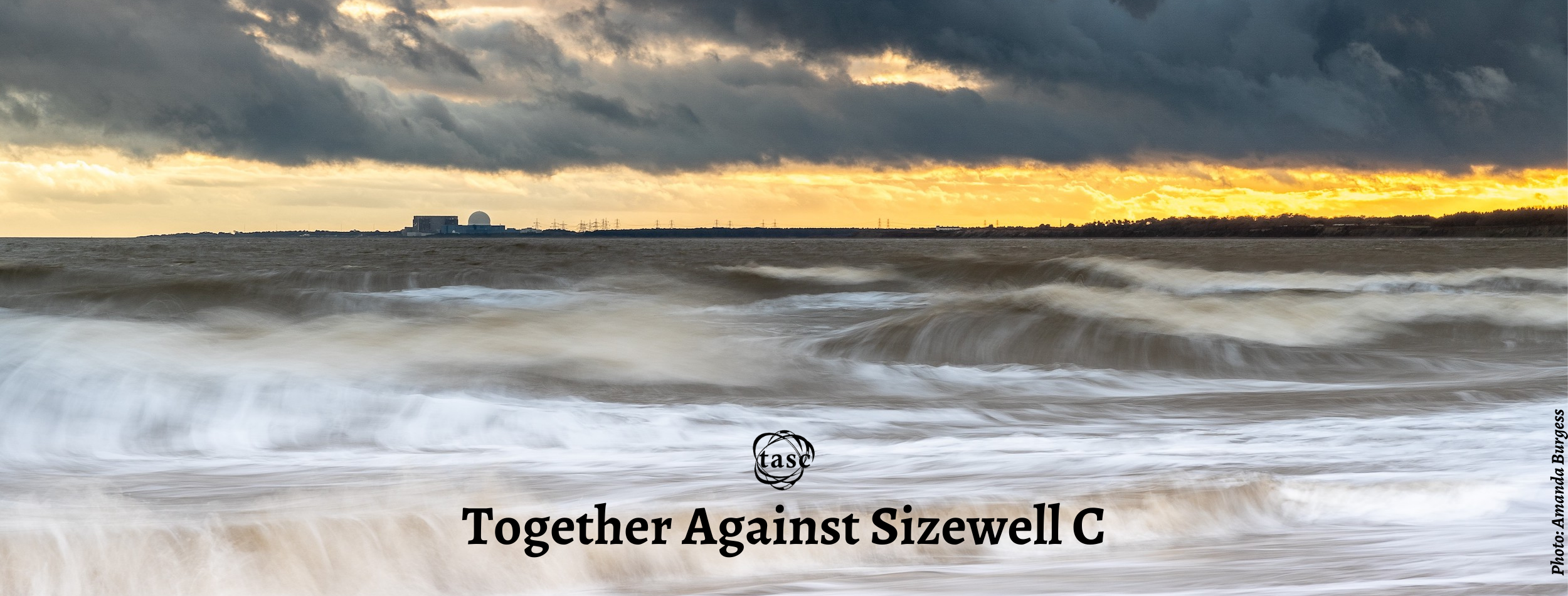
Reply from Gareth Davies 27.01.25
Follow-up letter from TASC 17.01.25
06.01.25
Dear Mr Davies,
SIZEWELL C
Whilst acknowledging your previous comments regarding TASC’s concerns for the UK taxpayer in relation to the Sizewell C project, TASC wishes to make further representations regarding more recent developments which highlight a risky project proceeding by stealth with no transparency regarding Value for Money (VfM). The Sizewell C DCO was approved based on an estimated capital cost of £20 billion, but with announcements that the sister project at Hinkley Point C is estimated to cost (at current prices) £46 billion and in the knowledge that the Sizewell site is a more difficult site to develop, it is not credible to suggest, as one of the developer’s joint managing directors did in 2024[1], the cost to build Sizewell C remains at £20 billion.
With reference to your letter of 17th June, TASC fully appreciates that it is a government decision whether to proceed with Sizewell C and we advise that we are not expecting the NAO, at the current time, to pre-judge the final decision or to review the current negotiations with potential investors. However, what is clear from recent developments is that the growing and already substantial government financial support for the project has been split into two separate funding streams, the first being for the period leading to the potential Final Investment Decision (FID), and the other being part of the FID should it be agreed. TASC has considerable concerns about the decision-making at this pre-FID stage of the project due to the risk to public finances and the lack of transparency regarding the VfM assessment which is being used to justify the current funding.
On 30th August 2024, DESNZ published details of the Sizewell C Development Expenditure
(Devex) Subsidy Scheme no. SC11179 (the ‘Devex’ scheme) which authorises a total subsidy of £5.5 billion, up to the date of a potential FID, the first tranche of which, amounting to £1.2 billion, was allocated without any transparency or announcement on 20th September 2024 (details of this payment were first disclosed to the public on the subsidy scheme website on 5th
December)[2]. Combined with the £2.5 billion granted through the ‘SZC Investment Funding Scheme (SC10655)’, this will take total taxpayer exposure to £8 billion. If we then add the £2.7 billion allocated to the project in the recent budget which, if not part of the Devex scheme, the exposure of public funds would extend to £10.7 billion – for a project that is not guaranteed to go ahead should there be no FID or satisfactory resolution of the many other key matters relating to the project. The Devex scheme states that allocations will be supported by VfM assessments.
In your letter of 15th May 2024, you advised that you were anticipating that FID would occur during the period of the previous Parliament. According to the Devex scheme, FID may not happen till June 2026. It is worth recalling that when EDF first proposed Sizewell C, they budgeted the costs to get to FID to be £458 million. With a £2.5 billion spend by the previous Tory government, £5.5 billion authorised by this government under the Devex Scheme and an estimated £700 million invested by EDF, the cost of getting to FID is approximately 1,900% of the original budget. Even by EDF’s previous underbudgeting history, this uplift is quite staggering, yet there has been no explanation as to why these costs are so astronomically higher than the original estimate, how such increases have been justified and how much more public funding is likely to be assigned to what many observers are calling ‘Labour’s HS2’.
TASC call on the NAO to carry out a review of the Value for Money assessment supporting the government decision to use up to £10.7 billion of public funding without any guarantee that the project will go ahead. There are many facets to the Sizewell C project that will have an impact on its viability and TASC take this opportunity to remind you of some of the risks why the project may not proceed:-
- Insufficient external funding, perhaps due to the many cost uncertainties raised in our letter of 29th April 2024, meaning that a final investment decision cannot be made.
- Assessment of the true costs of the project could lead to Sizewell C failing the value for money assessment, particularly as the government has advised that by 2030, the UK will be a net exporter of electricity[3] meaning that if and when Sizewell C ever becomes operational in the late 2030’s, it is likely to be surplus to the UK’s needs: even though Sizewell C’s DCO approval was justified on the grounds of ‘Imperative Reasons of Overriding Public Interest’.
- Sizewell C is proposed to be sited on one of Europe’s fastest eroding coastlines, yet there is still no final design of the sea defences required to keep it safe from the effects of climate change, so there is no guarantee that the Office for Nuclear Regulation (ONR) will be satisfied that the site can be kept safe for its full lifetime i.e. until the late 2100s. The future need for a final design of the sea defences, including the flood risk implications of the 20-year extension to the site lifetime (to that approved in the DCO) and the need to justify the proposed nuclear platform height, was recognised by the ONR when they issued a Nuclear Site Licence to Sizewell C in May 2024. If the ONR are not satisfied with the outstanding proposals, they will not licence Sizewell C’s operations.
- The project’s safety case currently being assessed by the ONR is materially different from the project that was approved in the DCO i.e. in respect of the commitment Sizewell C Ltd have made to install ‘Overland Flood Barriers’ and the 20-year extension to the site’s lifetime, meaning that the Secretary of State should review the updated project before opining whether the changes are acceptable.
- Sizewell C Ltd have still not completed investigations into the ground conditions beneath the nuclear site, much of which was originally marshland, to determine how and if the cut-off wall – essential to enable the dewatering of the whole nuclear site – can be constructed. Without the cut-off wall, Sizewell C cannot be built. TASC are not aware that ground testing has even started for the area that will be covered by the hard coast sea defences.
- Despite being located in the UK’s driest region, there is still no guaranteed sustainable source or agreement for the provision of the 2.2 million litres of potable water per day essential for Sizewell C’s sixty years of operation, meaning that the nuclear plant could be built but unable to operate.
TASC draw your attention to the evidence given by GBN’s interim CEO, Simon Bowen, at the 20th November 2024 meeting of the ESNZ Parliamentary committee[4], at which he indicated that one of the reasons for the delay in Sizewell C achieving a FID is, quote, “technical issues in getting the design to the stage where you can take it to final investment decision” and following a discussion about nuclear projects achieving value for money and how projects can be de-risked he said, quote, “How do you de-risk in the way that you do across all infrastructure projects? Well, you do not dig a hole until you have completed the design. It is as basic as that.” He then went on to say “If we can get to that stage, first, it makes it more investable for the private sector…”
In the light of Simon Bowen’s evidence and in recognition that the Sizewell C project is already digging a significant number of large holes throughout East Suffolk building or preparing projects which without Sizewell C would not be justified and are totally unnecessary. Such potentially redundant projects include:-
- the Sizewell Link road,
- Sizewell access road,
- SSSI Crossing,
- green rail route,
- two-village bypass,
- five roundabouts,
- park and ride sites,
- car parks, offices and laydown areas.
These projects currently employ a workforce of 1000, using heavy plant, devastating the biodiversity-rich environment and the AONB landscape in the process. This amounts to wholesale environmental vandalism, especially when the project still lacks a final design of the all-important sea defences and while the nuclear site’s ground stabilisation trials are incomplete. It should be acknowledged that the Sizewell C project has not followed Simon Bowen’s advice as it has not been ‘de-risked’, will therefore likely experience delays, cost overruns and will not provide true value for money, this being one of the many reasons why the project is putting public funds at risk. If the project does not go ahead, the writing off of billions worthlessly invested and the cost of remedial work to make good the damage Sizewell C has caused to East Suffolk will largely fall on the public purse.
TASC trust that there is now sufficient justification to support an NAO review of the value for money assessment relating to the pre-FID use of public funds for Sizewell C’s development costs together with an examination of the nature of the expenditure that has already taken place and of the budgets covering the intended use of public funds to ensure that the risk of loss to the public purse is minimised, should the project not achieve FID, as is entirely possible given that most serious financial institutions have declined to invest in such a risky project.
Yours sincerely,
Chris Wilson on behalf of TASC
[1] IPE Real Assets report of discussion with Julia Pyke April 2024 https://realassets.ipe.com/analysis/juliapyke–sizewell–c–has–been–heavily–de–risked–for–pension–funds/10072923.article
[2] Link to Sizewell C Ltd Devex subsidy scheme
https://searchforuksubsidies.beis.gov.uk/scheme/?scheme=SC11179
[3] Page 25 of government report ‘Clean Power 2030 Action Plan: A new era of clean electricity’ states “We expect delivering a clean power system with these characteristics will make Great Britain a net exporter of electricity and will reduce the carbon intensity of electricity generation from 171gCO2e/kWh in 202313 to well below 50gCO2e /kWh in 2030…”
https://assets.publishing.service.gov.uk/media/675bfaa4cfbf84c3b2bcf986/clean–power–2030–actionplan.pdf
[4] Transcript of second half of ESNZ Committee meeting 20th November 2024 The quotes are from the answers to questions 47 and 83 committees.parliament.uk/oralevidence/15023/pdf/

